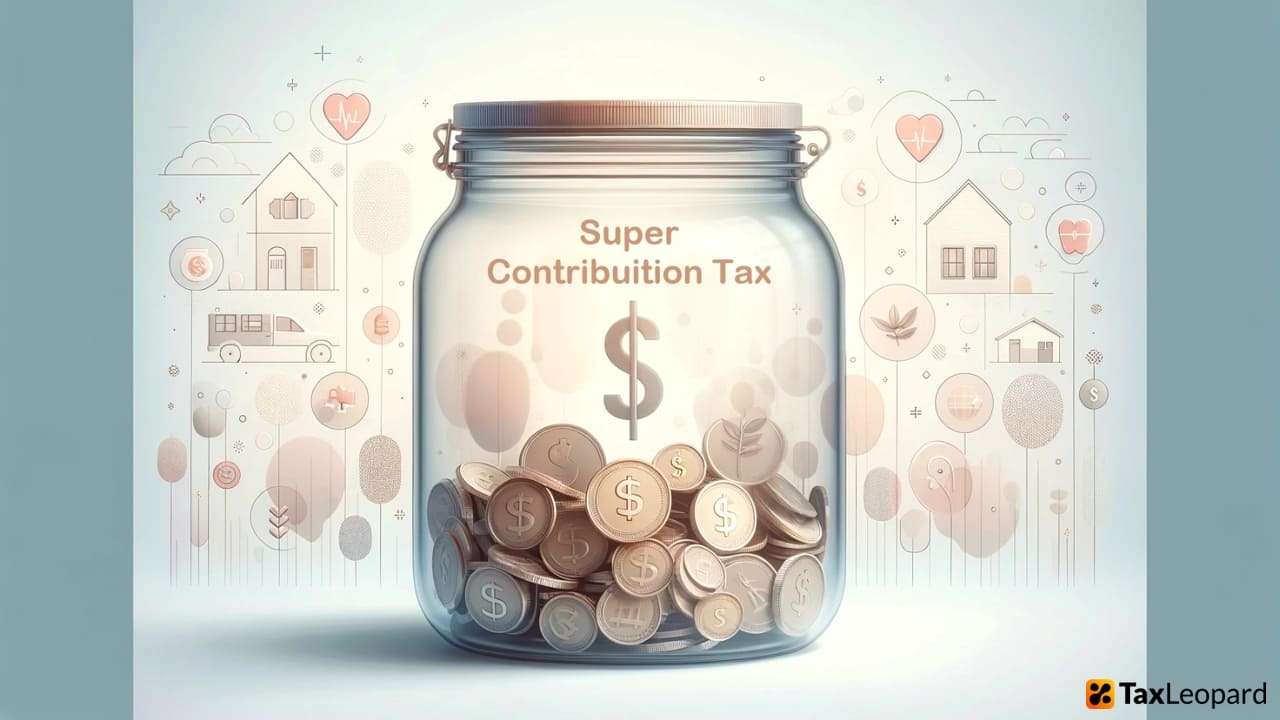Navigating the complexities of Super Contributions Tax can often feel like navigating a labyrinth. Many Australians find themselves perplexed by the intricate rules set by the Australian Taxation Office (ATO). Research indicates that a significant number of individuals struggle with understanding the tax implications on their superannuation contributions, whether concessional or non-concessional. This confusion can lead to unintended tax liabilities and missed opportunities for tax-efficient super growth.
Our guide aims to demystify these ATO rules, offering clear, actionable insights. We’ll explore the nuances of super contribution taxation, including caps, deductions, and special considerations, ensuring you are equipped to optimize your super contributions effectively.
Overview of Super Contributions
Concessional and Non-Concessional Contributions
Super contributions in Australia fall into two categories: concessional and non-concessional. The Australian Taxation Office taxes concessional contributions, like salary sacrifice contributions, at 15%, which is lower than the marginal tax rate. These contributions consist of employer contributions and personal contributions that claim a tax deduction. The concessional contribution cap limits the amount you can contribute at this lower tax rate.
Investors make non-concessional contributions from after-tax income, and these contributions do not incur further tax upon entering the super fund. However, there is a cap on the amount of non-concessional contribution you can make. If you exceed these caps, you may incur extra tax.
Understanding Superannuation

In Australia, superannuation serves as a method to save for retirement, under the regulation of the Australian Taxation Office (ATO). The super fund invests your contributions to grow over time. Your super account can accept concessional super contributions, which are subject to taxation at a concessional rate, and non-concessional contributions, which do not attract any additional tax.
The amount of tax you pay on super contributions depends on the type of contribution and your total super balance. Claiming a tax deduction for personal super contributions can reduce your income tax. Superannuation provides tax benefits like a tax offset to encourage saving for retirement.
Restrictions on Voluntary Contributions
Voluntary superannuation contributions come with specific restrictions set by the Australian government. The contribution caps, both concessional and non-concessional, limit the amount you can contribute each financial year. If your total super balance exceeds a certain threshold, it can affect your ability to make non-concessional contributions. The Division 293 tax imposes an additional tax on high-income earners making concessional contributions.
To claim a tax deduction for personal contributions, certain conditions must be met, and it’s important to declare these on your tax return. These restrictions are designed to ensure fairness and sustainability in the superannuation system.
Taxation of Super Contributions
Contributions Tax: How It Works
In Australia, contributions tax is levied on concessional super contributions. These contributions, including salary sacrifice contributions, are taxed at 15% by the super fund. This rate is often lower than the marginal tax rate, making it a tax-efficient way to save. The Australian Taxation Office oversees this process.
However, high-income earners may pay an extra Division 293 tax. This tax ensures fairness in the superannuation system, balancing the tax benefits across different income brackets. Contribution caps are in place to limit the amount contributed at these concessional rates.
Before-Tax Contributions
Before-tax contributions to a super fund, often called concessional contributions, include employer contributions and salary sacrifice contributions. These are contributions made from your income before income tax is applied. Concessional contributions are subject to a cap, beyond which extra tax applies. The Australian Taxation Office sets these caps, and they are crucial for tax planning.
Making concessional contributions reduces your taxable income, potentially lowering the amount of tax you pay. It’s a strategy many Australians use to see super growth while managing their immediate tax liabilities effectively.
After-Tax Contributions
After-tax contributions, also known as non-concessional contributions, are made from income that has already been taxed. These contributions are not subject to the 15% contributions tax. The Australian Taxation Office monitors a cap on after-tax contributions, limiting the amount you can contribute. If you exceed this cap, additional tax may apply.
After-tax contributions are a popular way to boost your super balance. They can provide tax benefits in the form of a tax offset, especially useful for those aiming to grow their super without incurring extra tax on their contributions.
The Role of Super Funds in Tax Management
Super funds play a critical role in managing the taxation of super contributions. They are responsible for deducting the 15% contributions tax on concessional contributions and ensuring compliance with contribution caps. Super funds also liaise with the Australian Taxation Office, reporting contributions and taxes paid.
They assist members in understanding how contributions are taxed and the impact on their total super balance. By effectively managing these aspects, super funds help Australians maximize their retirement savings and take advantage of available tax deductions and offsets.
Deduction for Personal Super Contributions
Growing Your Super
Strategies to Maximize Super Investment Earnings
Superannuation is taxed differently, allowing your investments to grow more efficiently. Regularly contributing to your super can significantly boost your retirement savings. Investing in a diverse portfolio within your super fund enhances potential earnings. Super co-contributions and the low-income superannuation tax offset can also increase your super balance.
Monitoring super investment earnings helps in adjusting strategies for better growth. Smart management of super funds, including rebalancing investments, plays a key role in maximizing earnings. Understanding capital gains tax implications within super can aid in better investment decisions.
The Impact of Voluntary Contributions on Super Growth
Making voluntary contributions to your super fund can substantially increase your retirement savings. Contributions above the super guarantee can count towards your non-concessional contributions cap. Voluntary after-tax contributions are called non-concessional and help grow your super tax-efficiently. These contributions, already taxed, don’t attract additional contributions tax within the super.
Employer super guarantee contributions, combined with personal voluntary contributions, can significantly boost your super. Voluntary contributions can also help in reaching the unused concessional contributions cap. Regular voluntary contributions each financial year can lead to considerable long-term growth.
Understanding the Tax You Pay on Super Contributions
Super contributions receive different tax treatments based on their type and amount. Your super fund taxes concessional contributions, like employer super, at a lower rate. You usually don’t pay extra tax on non-concessional contributions, which come from after-tax income. High-income earners pay Division 293 tax on certain super contributions.
Understanding the treatment of super contributions can help you manage your tax effectively. Your combined income and concessional super contributions determine the tax on your super contributions. By keeping track of the super contributions you make, you can effectively manage the tax you pay.
Regulations and Restrictions
Legal Framework Governing Super Contributions
The superannuation legal framework dictates the taxation of super contributions. The system taxes before-tax contributions, including employer super guarantee contributions, at a concessional rate. You make personal super contributions, which count towards your non-concessional contributions cap, from after-tax income. Under certain conditions, these contributions also qualify for a super co-contribution.
The superannuation guarantee ensures employers contribute to your super, while the income and concessional super contributions set limits on before-tax contributions. Excess concessional contributions may attract additional taxes, emphasizing the need to understand these regulations.
Restrictions on Voluntary Contributions
Voluntary contributions to your super fund, both concessional and non-concessional, are subject to annual caps. The system heavily taxes contributions that exceed the non-concessional cap to deter excessive contributions. You make non-concessional contributions, also known as after-tax super contributions, from your taxed income and they enter your super without additional tax.
However, these contributions count towards your non-concessional contributions cap. You can carry forward unused concessional contributions, offering flexibility. These restrictions aim to provide a balance between the opportunity to grow your super and measures that prevent excessive tax-advantaged savings.
Compliance and Penalties for Exceeding Contribution Caps
Compliance with super contribution caps is critical to avoid penalties. Exceeding the concessional contributions cap results in extra tax, as excess amounts are taxed at your marginal tax rate. For non-concessional contributions, surpassing the cap leads to additional taxes, discouraging over-contributing. The ATO monitors contributions each financial year, ensuring adherence to the caps.
Super funds report contributions to the ATO, enabling efficient tracking. Individuals who exceed these caps may apply to the ATO for special consideration in certain circumstances, highlighting the importance of careful contribution planning.
Conclusion
Understanding the ATO’s rules on Super Contributions Tax is pivotal for effectively managing your superannuation and securing a financially stable retirement. You can make informed decisions that align with your long-term financial goals by comprehending the nuances of concessional and non-concessional contributions, and the associated tax benefits and limitations. Our guide has aimed to simplify these complex regulations, providing you with the knowledge to navigate the superannuation landscape confidently. Are you now better prepared to evaluate your super contributions and their tax implications in line with the ATO’s guidelines?
FAQs
1. How are concessional super contributions taxed?
Australia taxes concessional super contributions at a concessional rate of 15%, as long as they fall within the contributions cap.
2. What is the cap for concessional super contributions?
The concessional super contributions cap is $27,500 per year, as of the latest update.
3. Are non-concessional contributions taxed in Australia?
Non-concessional contributions are not taxed upon entry to the super fund, as they are made from after-tax income.
4. What is the non-concessional contributions cap?
The cap for non-concessional contributions is $110,000 per year or $330,000 under the bring-forward rule.
5. Can I claim a tax deduction for personal super contributions?
Yes, you can claim a tax deduction for this, subject to certain conditions and limits.




